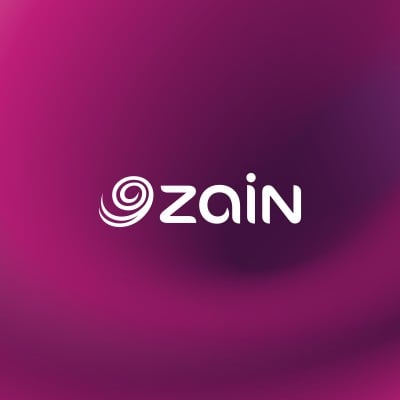Company Details
zain
15,982
321,194
517
zain.com
0
ZAI_8354262
In-progress

Zain Group Company CyberSecurity Posture
zain.comZain Group is a leading provider of innovative ICT technologies & digital lifestyle communications operating in 8 markets across the Middle East & Africa, serving 50.9 million active customers as of 30 June 2025. Zain provides mobile voice, data and B2B services in: Kuwait, Bahrain, Iraq, Jordan, Saudi Arabia, Sudan and South Sudan. Headquartered in the UAE, ZainTECH, the Group’s one-stop digital and ICT solutions provider, is playing a key role in the digital transformation of enterprise and government clientele across the MENA region. Also UAE based, Zain Omantel International (ZOI) is revolutionizing the international telecommunications wholesale landscape as the premier wholesale powerhouse serving regional operators, international carriers, and global hyperscalers. In Morocco, Zain has a 15.5% stake in ‘INWI’, through a joint venture. Zain is listed on the Boursa Kuwait (stock ticker: ZAIN). We recommend the Investor Community to download the “Zain Group Investor Relations” Mobile App. For more, please email [email protected]
Company Details
zain
15,982
321,194
517
zain.com
0
ZAI_8354262
In-progress
Between 750 and 799

 Zain Group Global Score (TPRM)
Zain Group Global Score (TPRM)XXXX

Description: Threat actors linked to China exploited the **ToolShell vulnerability (CVE-2025-53770)** in Microsoft SharePoint to breach a Middle Eastern telecommunications company shortly after its public disclosure in July 2025. The attack involved bypassing authentication and achieving **remote code execution (RCE)** on on-premise SharePoint servers, enabling persistent and stealthy access for **credential theft and espionage**. The **Salt Typhoon (Glowworm)** group deployed malicious tools like **Zingdoor, ShadowPad, and KrustyLoader**, a Rust-based loader previously tied to China-nexus espionage campaigns. The attackers aimed to **exfiltrate sensitive data**, establish long-term access, and likely gather intelligence for geopolitical or economic advantage. While no explicit data leak was confirmed, the compromise of a **telecom provider**—a critical infrastructure sector—poses risks to **national security, customer privacy, and regional stability**. The attack aligns with broader campaigns targeting **government agencies, universities, and financial institutions** globally, suggesting a coordinated effort by multiple Chinese state-sponsored groups. The use of **living-off-the-land (LotL) techniques** and privilege escalation exploits (e.g., **CVE-2021-36942/PetitPotam**) further obscured detection, increasing the potential for **unauthorized lateral movement** across networks.


No incidents recorded for Zain Group in 2025.
No incidents recorded for Zain Group in 2025.
No incidents recorded for Zain Group in 2025.
Zain Group cyber incidents detection timeline including parent company and subsidiaries

Zain Group is a leading provider of innovative ICT technologies & digital lifestyle communications operating in 8 markets across the Middle East & Africa, serving 50.9 million active customers as of 30 June 2025. Zain provides mobile voice, data and B2B services in: Kuwait, Bahrain, Iraq, Jordan, Saudi Arabia, Sudan and South Sudan. Headquartered in the UAE, ZainTECH, the Group’s one-stop digital and ICT solutions provider, is playing a key role in the digital transformation of enterprise and government clientele across the MENA region. Also UAE based, Zain Omantel International (ZOI) is revolutionizing the international telecommunications wholesale landscape as the premier wholesale powerhouse serving regional operators, international carriers, and global hyperscalers. In Morocco, Zain has a 15.5% stake in ‘INWI’, through a joint venture. Zain is listed on the Boursa Kuwait (stock ticker: ZAIN). We recommend the Investor Community to download the “Zain Group Investor Relations” Mobile App. For more, please email [email protected]


At Vodafone, we believe that connectivity is a force for good. If we use it for the things that really matter, it can improve people's lives and the world around us. Through our technology we empower people, connecting everyone regardless of who they are or where they live, we protect the planet a
We are driving the digital transition of Italy and Brazil with innovative technologies and services because we want to contribute to accelerating the sustainable growth of the economy and society by bringing value and prosperity to people, companies and institutions. We offer diversified solutions
We believe it’s people who give purpose to our technology. So we’re committed to staying close to our customers and providing them the best experience. And delivering the best tech. On the best network. Because our purpose is to build a connected future so everyone can thrive. We build techno
🤝Ce qui fait notre singularité ? Chez Bouygues Telecom, nous croyons que les relations humaines sont un besoin vital. La qualité de nos relations avec notre famille, nos amis, ceux qui nous entourent est déterminante pour notre bien-être, notre santé et même notre espérance de vie. Ce sont ces rela

Idea Cellular is an Aditya Birla Group Company, India's first truly multinational corporation. Idea is a pan-India integrated GSM operator offering 2G and 3G services, and has its own NLD and ILD operations, and ISP license. With revenue in excess of $4 billion; revenue market share of 18%; and subs

At TELUS, our purpose-driven team works together every day to innovate and do good. From providing technology solutions that make our lives safer and easier, to supporting those who need it most, our inclusive, spirited and giving people are passionate about empowering our customers, communities and

We advance how people connect with each other and the world #ConnectionIsEverything. Bell is Canada's largest communications company providing advanced Bell broadband wireless, Internet, TV, media and business communications services. Founded in Montréal in 1880, Bell is wholly owned by BCE Inc. T

Connecting Nation. Accelerating Indonesia's Future. As Indonesia's leading digital telecommunications company, Telkomsel is committed to building a connected, competitive, and future-ready society. For over 29 years, we've empowered individuals, homes, and businesses with innovative connectivity an

We are an award-winning international communications company operating across the Middle East, North Africa and Southeast Asia. Serving consumers and businesses in 10 countries, we deliver a leading data experience through a broad range of content and services via our advanced, data-centric mob
.png)
KUWAIT: Zain Kuwait sponsored the 4th edition of Watheefti, the largest career gathering in Kuwait. The event was held over the weekend at...
KUWAIT: Zain announced the successful conclusion of the second edition of the Academy X program in strategic partnership with CODED Academy,...
ZainTECH, the integrated digital solutions provider of Zain Group, has introduced its AI-powered managed security operations service...
This strategic move strengthens ZainTECH's leadership in cybersecurity-as-a-service across the Middle East and Africa.
The program aims to empower women and bridge the gender gap in cybersecurity by equipping young women with the skills and confidence needed to excel in this...
There's no sense of theatrics, no sweeping declarations delivered with Silicon Valley gloss. Instead, Hanna, CEO of ZainTECH, Zain Group's...
KUWAIT: The Kuwait Foundation for the Advancement of Sciences (KFAS) has concluded the “TechEdge” program conducted in collaboration with...
Rakuten Symphony said on Monday it has signed a Memorandum of Understanding (MoU) with Zain Kuwait to collaborate on a pilot project to deploy cloud-native 5G...
By Tamer Abdulaziz KUWAIT: By focusing on advanced infrastructure and enhancing digital experiences, Zain Kuwait plays an active role in...

Explore insights on cybersecurity incidents, risk posture, and Rankiteo's assessments.
The official website of Zain Group is https://www.zain.com.
According to Rankiteo, Zain Group’s AI-generated cybersecurity score is 774, reflecting their Fair security posture.
According to Rankiteo, Zain Group currently holds 0 security badges, indicating that no recognized compliance certifications are currently verified for the organization.
According to Rankiteo, Zain Group is not certified under SOC 2 Type 1.
According to Rankiteo, Zain Group does not hold a SOC 2 Type 2 certification.
According to Rankiteo, Zain Group is not listed as GDPR compliant.
According to Rankiteo, Zain Group does not currently maintain PCI DSS compliance.
According to Rankiteo, Zain Group is not compliant with HIPAA regulations.
According to Rankiteo,Zain Group is not certified under ISO 27001, indicating the absence of a formally recognized information security management framework.
Zain Group operates primarily in the Telecommunications industry.
Zain Group employs approximately 15,982 people worldwide.
Zain Group presently has no subsidiaries across any sectors.
Zain Group’s official LinkedIn profile has approximately 321,194 followers.
Zain Group is classified under the NAICS code 517, which corresponds to Telecommunications.
No, Zain Group does not have a profile on Crunchbase.
Yes, Zain Group maintains an official LinkedIn profile, which is actively utilized for branding and talent engagement, which can be accessed here: https://www.linkedin.com/company/zain.
As of November 27, 2025, Rankiteo reports that Zain Group has experienced 1 cybersecurity incidents.
Zain Group has an estimated 9,535 peer or competitor companies worldwide.
Incident Types: The types of cybersecurity incidents that have occurred include Cyber Attack.
Detection and Response: The company detects and responds to cybersecurity incidents through an third party assistance with broadcom's symantec threat hunter team (investigation), and remediation measures with patching cve-2025-53770 (if not already applied)..
Title: Exploitation of CVE-2025-53770 (ToolShell) in Microsoft SharePoint by China-Linked Threat Actors
Description: Threat actors with ties to China exploited the ToolShell security vulnerability (CVE-2025-53770) in Microsoft SharePoint to breach multiple entities globally, including a telecommunications company in the Middle East, government departments in Africa and South America, a U.S. university, a state technology agency in Africa, a government department in the Middle East, and a finance company in Europe. The attacks involved bypassing authentication to achieve remote code execution, deploying malware (e.g., Zingdoor, ShadowPad, KrustyLoader), and leveraging living-off-the-land (LotL) tools for credential theft and persistence. The activity is attributed to multiple China-nexus groups, including Linen Typhoon, Violet Typhoon, Storm-2603, and Salt Typhoon, with motives likely tied to espionage.
Date Publicly Disclosed: 2025-07
Type: Cyber Espionage
Attack Vector: Exploitation of Public-Facing Application (CVE-2025-53770)DLL Side-LoadingPrivilege Escalation (CVE-2021-36942)Living-off-the-Land (LotL) Tools
Vulnerability Exploited: CVE-2025-53770 (ToolShell, patch bypass for CVE-2025-49704/CVE-2025-49706)CVE-2021-36942 (PetitPotam)Unspecified SQL Server VulnerabilitiesUnspecified Adobe ColdFusion Vulnerabilities
Threat Actor: Linen Typhoon (Budworm)Violet Typhoon (Sheathminer)Storm-2603Salt Typhoon (Glowworm)UNC5221 (suspected overlap)
Motivation: EspionageCredential TheftPersistent Access
Common Attack Types: The most common types of attacks the company has faced is Cyber Attack.
Identification of Attack Vectors: The company identifies the attack vectors used in incidents through Exploited Microsoft SharePoint (CVE-2025-53770)SQL ServersAdobe ColdFusion Vulnerabilities.

Data Compromised: Credentials, Potentially sensitive government/telecom/financial data
Systems Affected: Microsoft SharePoint Servers (On-Premise)SQL ServersApache HTTP Servers with Adobe ColdFusionDomain Controllers (via CVE-2021-36942)
Brand Reputation Impact: Potential reputational damage to affected entities (e.g., telecom company, government agencies)
Identity Theft Risk: High (due to credential theft)
Commonly Compromised Data Types: The types of data most commonly compromised in incidents are Credentials, Potentially Government/Telecom/Financial Data and .

Entity Name: Unnamed Telecommunications Company
Entity Type: Private
Industry: Telecommunications
Location: Middle East

Entity Name: Government Departments (Multiple)
Entity Type: Government
Industry: Public Sector
Location: Africa

Entity Name: Government Agencies
Entity Type: Government
Industry: Public Sector
Location: South America

Entity Name: Unnamed University
Entity Type: Educational
Industry: Higher Education
Location: United States

Entity Name: State Technology Agency
Entity Type: Government
Industry: Technology
Location: Africa

Entity Name: Government Department
Entity Type: Government
Industry: Public Sector
Location: Middle East

Entity Name: Finance Company
Entity Type: Private
Industry: Financial Services
Location: Europe

Third Party Assistance: Broadcom'S Symantec Threat Hunter Team (Investigation).
Remediation Measures: Patching CVE-2025-53770 (if not already applied)
Third-Party Assistance: The company involves third-party assistance in incident response through Broadcom's Symantec Threat Hunter Team (investigation), .

Type of Data Compromised: Credentials, Potentially government/telecom/financial data
Sensitivity of Data: High (government, telecom, financial sectors targeted)
Data Exfiltration: Likely (for espionage purposes)
Prevention of Data Exfiltration: The company takes the following measures to prevent data exfiltration: Patching CVE-2025-53770 (if not already applied), .

Ransomware Strain: WarlockLockBitBabuk (deployed by Storm-2603 in unrelated recent attacks)

Lessons Learned: 1. Patch management is critical, especially for publicly disclosed vulnerabilities like CVE-2025-53770, which was exploited even after patches were available. 2. China-nexus threat actors continue to target high-value sectors (telecom, government, finance) for espionage, leveraging both zero-days and known vulnerabilities. 3. Defense-in-depth strategies (e.g., monitoring for LotL tools, privilege escalation attempts) are essential to detect post-exploitation activity.

Recommendations: 1. Immediate patching of Microsoft SharePoint servers for CVE-2025-53770 and related flaws (CVE-2025-49704, CVE-2025-49706). 2. Audit and harden SQL servers and Adobe ColdFusion instances to prevent exploitation via side-loading or other techniques. 3. Monitor for indicators of compromise (IoCs) tied to KrustyLoader, ShadowPad, Zingdoor, and other tools used in these attacks. 4. Implement multi-factor authentication (MFA) and least-privilege access controls to mitigate credential theft risks. 5. Enhance logging and detection for privilege escalation attempts (e.g., PetitPotam exploitation). 6. Conduct threat hunting for signs of persistent access or backdoors established by China-linked groups.
Key Lessons Learned: The key lessons learned from past incidents are 1. Patch management is critical, especially for publicly disclosed vulnerabilities like CVE-2025-53770, which was exploited even after patches were available. 2. China-nexus threat actors continue to target high-value sectors (telecom, government, finance) for espionage, leveraging both zero-days and known vulnerabilities. 3. Defense-in-depth strategies (e.g., monitoring for LotL tools, privilege escalation attempts) are essential to detect post-exploitation activity.
Implemented Recommendations: The company has implemented the following recommendations to improve cybersecurity: 1. Immediate patching of Microsoft SharePoint servers for CVE-2025-53770 and related flaws (CVE-2025-49704, CVE-2025-49706). 2. Audit and harden SQL servers and Adobe ColdFusion instances to prevent exploitation via side-loading or other techniques. 3. Monitor for indicators of compromise (IoCs) tied to KrustyLoader, ShadowPad, Zingdoor, and other tools used in these attacks. 4. Implement multi-factor authentication (MFA) and least-privilege access controls to mitigate credential theft risks. 5. Enhance logging and detection for privilege escalation attempts (e.g. and PetitPotam exploitation). 6. Conduct threat hunting for signs of persistent access or backdoors established by China-linked groups..

Source: Broadcom's Symantec Threat Hunter Team

Source: Synacktiv (KrustyLoader analysis)
Date Accessed: 2024-01
Additional Resources: Stakeholders can find additional resources on cybersecurity best practices at and Source: Broadcom's Symantec Threat Hunter Team, and Source: Synacktiv (KrustyLoader analysis)Date Accessed: 2024-01.

Investigation Status: Ongoing (attribution to specific groups remains inconclusive; evidence points to China-based actors)

Entry Point: Exploited Microsoft Sharepoint (Cve-2025-53770), Sql Servers, Adobe Coldfusion Vulnerabilities,
Backdoors Established: ['ShadowPad', 'KrustyLoader', 'Zingdoor']
High Value Targets: Telecommunications Infrastructure, Government Networks, Financial Data,
Data Sold on Dark Web: Telecommunications Infrastructure, Government Networks, Financial Data,

Root Causes: 1. Delayed or incomplete patching of critical vulnerabilities (CVE-2025-53770). 2. Insufficient monitoring for post-exploitation activity (e.g., LotL tools, privilege escalation). 3. Overlap in tools/TTPs with previously attributed China-linked groups (e.g., Glowworm) suggests targeted espionage campaigns.
Corrective Actions: 1. Accelerate vulnerability management processes for high-severity flaws. 2. Deploy behavioral detection for malware loaders (e.g., KrustyLoader) and espionage tools (e.g., ShadowPad). 3. Isolate and segment high-value systems (e.g., government/telecom networks) to limit lateral movement. 4. Conduct red team exercises to test defenses against similar attack chains.
Post-Incident Analysis Process: The company's process for conducting post-incident analysis is described as Broadcom'S Symantec Threat Hunter Team (Investigation), .
Corrective Actions Taken: The company has taken the following corrective actions based on post-incident analysis: 1. Accelerate vulnerability management processes for high-severity flaws. 2. Deploy behavioral detection for malware loaders (e.g., KrustyLoader) and espionage tools (e.g., ShadowPad). 3. Isolate and segment high-value systems (e.g., government/telecom networks) to limit lateral movement. 4. Conduct red team exercises to test defenses against similar attack chains..
Last Attacking Group: The attacking group in the last incident was an Linen Typhoon (Budworm)Violet Typhoon (Sheathminer)Storm-2603Salt Typhoon (Glowworm)UNC5221 (suspected overlap).
Most Recent Incident Publicly Disclosed: The most recent incident publicly disclosed was on 2025-07.
Most Significant Data Compromised: The most significant data compromised in an incident were Credentials, Potentially Sensitive Government/Telecom/Financial Data and .
Most Significant System Affected: The most significant system affected in an incident was Microsoft SharePoint Servers (On-Premise)SQL ServersApache HTTP Servers with Adobe ColdFusionDomain Controllers (via CVE-2021-36942).
Third-Party Assistance in Most Recent Incident: The third-party assistance involved in the most recent incident was broadcom's symantec threat hunter team (investigation), .
Most Sensitive Data Compromised: The most sensitive data compromised in a breach were Potentially Sensitive Government/Telecom/Financial Data and Credentials.
Most Significant Lesson Learned: The most significant lesson learned from past incidents was 1. Patch management is critical, especially for publicly disclosed vulnerabilities like CVE-2025-53770, which was exploited even after patches were available. 2. China-nexus threat actors continue to target high-value sectors (telecom, government, finance) for espionage, leveraging both zero-days and known vulnerabilities. 3. Defense-in-depth strategies (e.g., monitoring for LotL tools, privilege escalation attempts) are essential to detect post-exploitation activity.
Most Significant Recommendation Implemented: The most significant recommendation implemented to improve cybersecurity was 1. Immediate patching of Microsoft SharePoint servers for CVE-2025-53770 and related flaws (CVE-2025-49704, CVE-2025-49706). 2. Audit and harden SQL servers and Adobe ColdFusion instances to prevent exploitation via side-loading or other techniques. 3. Monitor for indicators of compromise (IoCs) tied to KrustyLoader, ShadowPad, Zingdoor, and other tools used in these attacks. 4. Implement multi-factor authentication (MFA) and least-privilege access controls to mitigate credential theft risks. 5. Enhance logging and detection for privilege escalation attempts (e.g. and PetitPotam exploitation). 6. Conduct threat hunting for signs of persistent access or backdoors established by China-linked groups..
Most Recent Source: The most recent source of information about an incident are Synacktiv (KrustyLoader analysis) and Broadcom's Symantec Threat Hunter Team.
Current Status of Most Recent Investigation: The current status of the most recent investigation is Ongoing (attribution to specific groups remains inconclusive; evidence points to China-based actors).
.png)
Angular is a development platform for building mobile and desktop web applications using TypeScript/JavaScript and other languages. Prior to versions 19.2.16, 20.3.14, and 21.0.1, there is a XSRF token leakage via protocol-relative URLs in angular HTTP clients. The vulnerability is a Credential Leak by App Logic that leads to the unauthorized disclosure of the Cross-Site Request Forgery (XSRF) token to an attacker-controlled domain. Angular's HttpClient has a built-in XSRF protection mechanism that works by checking if a request URL starts with a protocol (http:// or https://) to determine if it is cross-origin. If the URL starts with protocol-relative URL (//), it is incorrectly treated as a same-origin request, and the XSRF token is automatically added to the X-XSRF-TOKEN header. This issue has been patched in versions 19.2.16, 20.3.14, and 21.0.1. A workaround for this issue involves avoiding using protocol-relative URLs (URLs starting with //) in HttpClient requests. All backend communication URLs should be hardcoded as relative paths (starting with a single /) or fully qualified, trusted absolute URLs.
Forge (also called `node-forge`) is a native implementation of Transport Layer Security in JavaScript. An Uncontrolled Recursion vulnerability in node-forge versions 1.3.1 and below enables remote, unauthenticated attackers to craft deep ASN.1 structures that trigger unbounded recursive parsing. This leads to a Denial-of-Service (DoS) via stack exhaustion when parsing untrusted DER inputs. This issue has been patched in version 1.3.2.
Forge (also called `node-forge`) is a native implementation of Transport Layer Security in JavaScript. An Integer Overflow vulnerability in node-forge versions 1.3.1 and below enables remote, unauthenticated attackers to craft ASN.1 structures containing OIDs with oversized arcs. These arcs may be decoded as smaller, trusted OIDs due to 32-bit bitwise truncation, enabling the bypass of downstream OID-based security decisions. This issue has been patched in version 1.3.2.
Suricata is a network IDS, IPS and NSM engine developed by the OISF (Open Information Security Foundation) and the Suricata community. Prior to versions 7.0.13 and 8.0.2, working with large buffers in Lua scripts can lead to a stack overflow. Users of Lua rules and output scripts may be affected when working with large buffers. This includes a rule passing a large buffer to a Lua script. This issue has been patched in versions 7.0.13 and 8.0.2. A workaround for this issue involves disabling Lua rules and output scripts, or making sure limits, such as stream.depth.reassembly and HTTP response body limits (response-body-limit), are set to less than half the stack size.
Suricata is a network IDS, IPS and NSM engine developed by the OISF (Open Information Security Foundation) and the Suricata community. In versions from 8.0.0 to before 8.0.2, a NULL dereference can occur when the entropy keyword is used in conjunction with base64_data. This issue has been patched in version 8.0.2. A workaround involves disabling rules that use entropy in conjunction with base64_data.

Get company history
















Every week, Rankiteo analyzes billions of signals to give organizations a sharper, faster view of emerging risks. With deeper, more actionable intelligence at their fingertips, security teams can outpace threat actors, respond instantly to Zero-Day attacks, and dramatically shrink their risk exposure window.
Identify exposed access points, detect misconfigured SSL certificates, and uncover vulnerabilities across the network infrastructure.
Gain visibility into the software components used within an organization to detect vulnerabilities, manage risk, and ensure supply chain security.
Monitor and manage all IT assets and their configurations to ensure accurate, real-time visibility across the company's technology environment.
Leverage real-time insights on active threats, malware campaigns, and emerging vulnerabilities to proactively defend against evolving cyberattacks.




